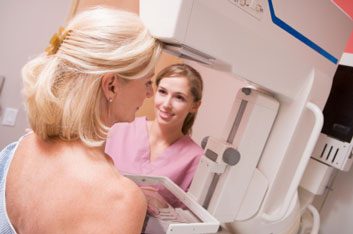
Scientific advances to celebrate
Women and their loved ones can collectively high-five: There truly are-like never before-surprising and exciting scientific advances in breast cancer prevention, detection and treatment. According to Dr. Sian Bevan, director of research at the Canadian Cancer Society, many are just now emerging after decades of laborious genome mapping and identification of specific genes responsible for cancers, including breast cancers. “We know so much more about genes, what they’re doing, and what role they are playing in the disease.”
Scientists have also recently made a huge stride in identifying genetic differences between primary cancer and metastatic cancers (those that spread)-which is the largest cause of breast-cancer mortality. That could lead to treatments that save yet more lives, Bevan says. The breast-cancer survival rate (measured five years after diagnosis) is now 88 percent, up from 79 percent 25 years ago. “Even though that’s great progress, there’s still work to be done, and that requires continued focus and funding of research,” she adds. Meantime, here are the exciting advancements.

Most promising breakthrough in keeping the disease at bay
“The majority of cancer-related deaths are due to metastasis [spread from primary tumour site], yet there are no approved targeted drugs that have shown significant benefit specifically in treating that spread,” explains Dr. Vivek Mittal, an associate professor of cell and developmental biology in cardiothoracic surgery and director of the Neuberger Berman Foundation Lung Cancer Laboratory at Weill Cornell Medical College in New York City. In the spring of 2013, Weill scientists explained why some people’s cancers don’t spread. In those individuals, they found there are two key proteins “poisoning the soil” by generating a micro-environment that blocks cancer cells from settling, and growing, in distant organs. The scientists believe a drug made of these proteins has the potential to block cancer. “We have work to do on exploiting these insights, but our findings are, so far, very exciting,” says Mittal. It could also lead to a test to predict whether a cancer will spread.

Most surprising preventive discovery
Early in 2013, a study in Cancer Causes & Control of 1,200 healthy women showed that those with low vitamin D levels during a three-month period before diagnosis had three times the breast-cancer risk as women with the highest vitamin D levels. That three-month window is when the tumour is most actively recruiting blood vessels required for tumour growth, says principal investigator Cedric Garland, professor in the department of family and preventive medicine at UC San Diego. Dr. Sandhya Pruthi, associate professor of medicine at the Mayo Clinic in Rochester, Minn., has been doing research in vitamin D and its relationship to breast-cancer prevention, and says it’s showing a strong connection. The Canadian Cancer Society recommends 1,000 IU of vitamin D daily during the winter months, or year-round if you are over 50, have dark skin, wear clothing that covers most of your skin, or don’t get outside much. Other bodies, including the U.S. National Academy of Sciences Institute of Medicine, recommend as much as 4,000 IU.

Best hope for prevention, post-menopause
A drug called exemestane (Aromasin), which decreases estrogen in the body, is given to women with breast cancer to prevent recurrence. A massive clinical trial a few years ago showed it also reduces by 65 percent the risk of breast cancer occurring in high-risk post-menopausal healthy women-with minimal side effects. The only other two drugs on the market for preventing breast cancer are tamoxifen and raloxifene, both estrogen modulators, and they cause side effects in most women. Pruthi points out that a personalized blood test may be able to further help doctors know which women would be most likely to benefit from taking this drug to reduce the risk of cancer.

Big development in detecting the risk of breast cancer
Currently, doctors commonly use one model (called “Gail”) to calculate a woman’s risk (for those with a strong family history, a different model, called “IBIS,” is used). Each asks a series of questions, but neither is as accurate as doctors would like.
But last year, researchers at Imperial College London (England) and the Mayo Clinic discovered clear indicators of epigenetic “on” switches for several different cancers, including breast. These indicators can be spotted with a simple blood test. “This is very exciting, because we will be able to tailor prevention strategies for each woman based on her personal risk,” says Pruthi. “And the blood test could be available in the next few years.”

Two new detection-imaging technologies coming soon
Mammography, the gold standard in detection technology, catches 85 percent of breast cancer in women where the breast tissue is primarily fatty-replaced (after menopause, the breast tissue of most women is replaced by fat), but it catches only 60 percent of cancers in women with dense breasts (more tissue than fat). Breast tomosynthesis (BT) and breast-specific gamma imaging (BSGI) are future technologies that are expected to offer better analysis for women with dense breast tissue. Before either of these technologies can be made widely available (they are currently being tested), scientists are working on reducing their radiation exposure (twice that of a mammogram) and cost, says Pruthi.
• BT is similar to mammography, but it takes 3-D thin-sliced X-ray images, which are then combined to create a more detailed view. This could be widely available in North America within the next few years, says Pruthi.
• BSGI uses a gamma camera to track how an injected radiopharmaceutical is taken up in the breast (higher amounts are found in tumours). In one study, BSGI showed a 100 percent detection rate while maintaining a reasonable rate of false positives. “The hope is that this will reveal things that a mammogram might miss,” adds Pruthi. “But again, radiation exposure will need to be reduced before it will become readily available.” BT will likely be available sooner.

Promising prognosis tools
During treatment, doctors need to make a prognosis of the state of a breast cancer and predict how well it will respond to treatments. The biggest advancement to date comes from discoveries in “gene expression profiling.” Specifically, this uses a sample of breast-cancer tissue to analyze the activity of 21 genes that indicate the likelihood that a patient’s estrogen-receptor (ER)-positive breast cancer-75 percent of all breast cancers-will spread or come back. Equipped with this knowledge, doctors can decide which women are most likely to benefit from additional chemotherapy as well as hormone therapy.
For example, “most patients with early-stage ER-positive breast cancer remain cancer-free after five years of treatment, but they remain at risk of recurrence for 15 years or longer,” according to Dr. Dennis Sgroi of the Massachusetts General Hospital (MGH) Cancer Center in Boston. A study in the Journal of The National Cancer Institute has identified a genetic biomarker that shows which women will continue to have a higher risk, and thus benefit from additional treatment. “This means about 60 percent of women with the most common breast cancer will be spared unnecessary treatment with the concomitant side effects and costs,” says study co-author Paul E. Goss, director of the breast cancer research program at the MGH Cancer Center. “But more importantly, the 40 percent of patients who are at risk of recurrence can now be identified as needing continued therapy, and many will be spared death from breast cancer.”

Hope for a sharpshooter drug
This year, a new first-of-its-kind drug received approval from Canadian and U.S. regulatory authorities for testing in breast- and ovarian-cancer patients-and it was developed thanks to donor and grant dollars. The drug, CFI-400945, gets the name “sharpshooter” because it targets cancer cells only. “Traditional chemotherapy is non-specific, like throwing a bomb in a hall and hoping you will kill more bad guys than good,” explains researcher and drug co-creator Dr. Tak Mak, who is director of The Campbell Family Cancer Research Institute at the Princess Margaret Cancer Centre in Toronto.
CFI-400945 targets an enzyme that plays a crucial role in cell division, particularly cancer cells. In the lab, the drug inhibited growth of human breast and ovarian cancers, as well as other cancers. Mak says they’ll know in two years if the oral drug is successful in humans, and if so, it could actually be available in another four to six years.

Two other exciting targeted treatments
At the beginning of 2013, the drug Kadcyla (or T-DM1) got approval from the U.S. Food and Drug Administration to treat patients with metastatic HER2-positive breast cancer (about 20 to 25 percent of all breast cancers) who were previously treated with Herceptin, the current gold standard. T-DM1 contains an agent that acts like a GPS, discriminating between healthy and diseased tissues without crashing into healthy cells. Health Canada is expected to approve it before the end of the year.
Imagine if you could rev up the body’s immune system to kill breast cancer cells before they really got to work. Interleukin-24, or IL-24, promises to do just that based on preliminary studies by Virginia Commonwealth University Massey Cancer Center and VCU Institute of Molecular Medicine. The IL-24 gene shoots straight to the tumour, bypassing healthy cells by catching a ride on a manipulated adenovirus; in animal studies, this inhibited tumour growth. “This therapy may someday eradicate both early and advanced breast cancer, and could even reduce the risk of recurrence,” says Paul B. Fisher, co-leader of the Cancer Molecular Genetics Program at VCU Massey.

New way to prolong survival
mTOR is a critical regulator of several normal cell processes, but unfortunately its signalling pathway is also highly active in many cancer cells. In studies, one drug-everolimus (Afinitor)-controlled mTOR, extending the length of time study participants lived without cancer progression by over four months. Health Canada approved it for use for post-menopausal women with resistant hormone-receptor positive advanced breast cancer at the start of 2013.

Two discoveries for advanced and hard-to-treat breast cancers
Cells’ “little helpers”-proteins called PARP1-rush to help cells whose DNA is damaged or mutated. However, doctors don’t want them rushing to help cancer cells that have just been crushed by chemotherapy or radiation. Very early studies show that standard therapies combined with PARP inhibitors may be more effective than standard therapies alone. Studies are underway in BRCA1 or BRCA2 patients (breast tumours with inherent DNA repair defects-about five percent of all breast cancers), and research is also being done to find out whether PARP inhibitors will work in other types of breast cancer.
Epothilones are a new class of drug that prevent cancer cells from dividing. And the brand Ixempra is showing promise in treating metastatic breast cancer that is resistant to other types of chemotherapy. Triple-negative breast-cancer patients (around 10 to 20 percent of all breast cancer patients), who have limited treatment options, may also respond to this drug.
Related:
• The killer cancer gene: What you should know about BRCA
• “I survived breast cancer – twice.”
• 10 foods that fight breast cancer
